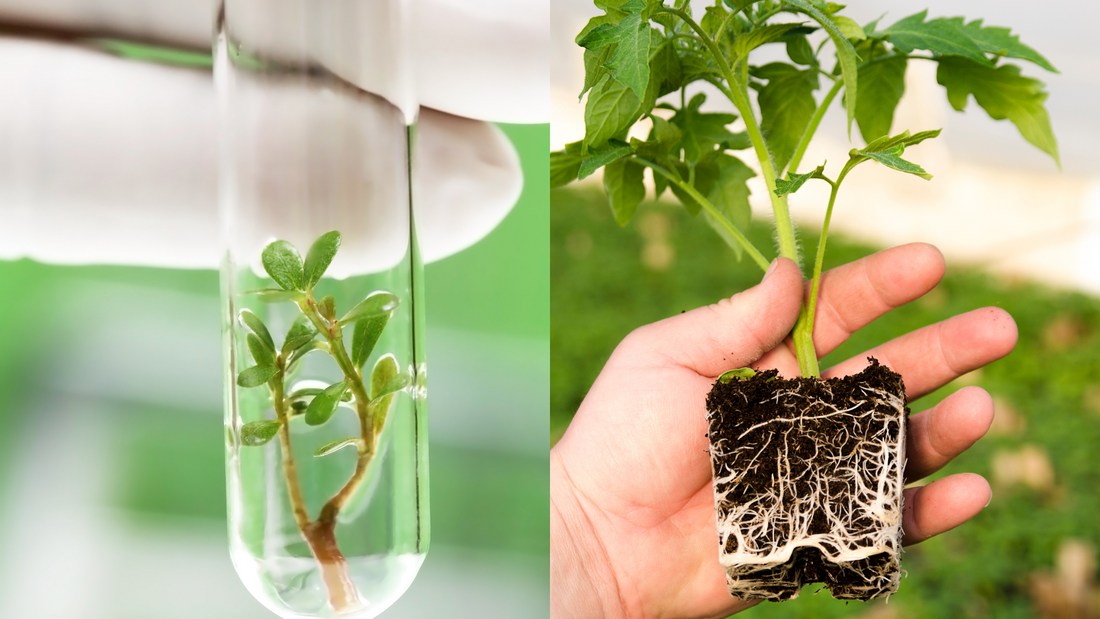
Difference Between Multiplication Media and Rooting Media
As a content and community manager, I leverage my expertise in plant biotechnology, passion for tissue culture, and writing skills to create compelling articles, simplifying intricate scientific concepts, and address your inquiries. As a dedicated science communicator, I strive to spark curiosity and foster a love for science in my audience.


Introduction
Tissue culture market is gaining momentum in the plant business. The advantages being offered by the technique are what attract people to install this approach in their business model. The technique only requires a small size of tissue to be cultured in an artificial media and a complete aseptic lab environment to regenerate an entire plant.
But, why sudden expansion in the applications of the technique?
With the growing population, the market of agriculture, horticulture, and floriculture are expanding at a dramatic rate. The skyrocketing demands of fruits, vegetables, flowers, or any indoor plants cannot be solely fulfilled by the traditional approaches that we have been using for ages, such as grafting, cutting, layering, or seed propagation.
It’s mainly because of several challenges we need to tackle while growing plants using these traditional approaches:
- Slow growth rate of plants
- Less viable plants
- Attack of diseases and pests
- Poor yield
- Seasonal growth of plants
- Too much labor work with everything majorly dependent on natural environmental conditions
- Not helpful in conservation of plants species
- Requirement of a large land
- Requirement of a large number of mother plants

The alternative solution to all these problems is tissue culture.
In this article, we learn more about the tissue culture technique, different types of tissue culture media, and the difference between “multiplication and rooting media”.
Stages of Tissue Culture
Tissue culture is a multi-step process. It involves four stages to convert a plant from a few tissues to an entire mature plant:
Establishment Stage
In this stage, the mother plant is chosen and the source of the explant (tissue needs to be cultured) is obtained. Then, the explant is cut out from the source part of the plant and surface sterilized using a few chemicals, such as bleach or Tween 20, or any surfactant based on the type of tissue.
After disinfecting explants, they are transferred to a simple basal tissue culture media for their establishment in lab conditions. The basal media most of the time consists of full-strength MS media, sugar, vitamins, and agar.
Multiplication Stage
After the explant is established in the lab condition, they are transferred to a fresh culture medium for shoot regeneration. The culture media used at this stage is known as multiplication media, which contains supplements of a plant hormone (cytokinin). Often, shoots obtained at this stage are further divided and subcultured into a fresh medium made using the same components.

Rooting Stage
When shoots at the multiplication stage grow to 2-4 cm, they are transferred to a fresh rooting medium, which contains the rooting plant hormone, auxin. This lead to the regeneration of roots and prepares in vitro plants to get transferred to the acclimation stage. The plant developed with roots at this stage is known as a plantlet.
Acclimation Stage
After plantlets are developed, they are ready to get transferred to the greenhouse. Acclimatization is the adaptation of organisms to a new environment. Plants transferred from the lab to the soil are subjected to abiotic stressors like temperature, light intensity, and humidity changes, as well as biotic stressors like soil microflora (microbes living in soil). Hence, successful acclimatization to the natural environment requires a step-by-step procedure.
Tissue Culture Media and Its Types

Tissue culture medium is an artificially prepared plant food required for the proper growth and development of plants in vitro! It consists of macro and micronutrients, vitamins, and sugar that facilitates the growth of plants.
Tissue culture media can be classified into two different ways:
Based on concentration of agar
Tissue culture media can be prepared in three different consistency based on the concentration of agar.
- Liquid media: It contains zero agar and has a liquid consistency.
- Semi-solid media: It contains more agar compared to liquid media and lesser than that solid media. It has 0.2-0.5% agar in concentration. It’s now flowy as liquid and not stiff as solid. It has a gel-like consistency.
- Solid media: It’s solid—soft but stiffer compared to the semi-solid medium. It contains 1-2% agar in the medium.
-
Based on the tissue culture stage in which the particular media is used
Based on the tissue culture stage medium is used, it’s classified as:
- Establishment medium: The media is prepared in the establishment stage of tissue culture. It contains components required to induce callus formation from the explant.
- Multiplication medium: It’s prepared at the multiplication stage of tissue culture. It contains plant components that induce shooting in plants.
- Rooting medium: The medium is prepared at the rooting phase of tissue culture. It contains auxin to induce root development in plants.
Multiplication Media Vs. Rooting Media

Many of our beginner culturists asked us this question “what are multiplication and rooting media and how do they differ?” So, we have curated this section only to answer the asked question.
The multiplication media is prepared at the multiplication stage. It contains the cytokinin hormone required for the shoot generation of in vitro plants. In tissue culture, the most commonly used cytokinins are zeatin, 2-iP, dihydro-zeatin, and zeatin riboside. Whereas, the synthetic analogs of cytokinins widely used in tissue culture media include kinetin and BAP (benzylaminopurine).

Figure: Shoot regeneration in plants placed in multiplication media.
Often a good ratio of cytokinin and auxin is required for the shoot or root generation of plants in lab conditions. For example, a high auxin-to-cytokinin ratio favors root formation, a high cytokinin-to-auxin ratio favors shoot formation, and the formation of callus occurs at an intermediate level of both the hormones (auxin and cytokinin).
Rooting media is prepared at the rooting phase of the tissue culture. It contains auxin hormone that induces root regeneration in developed shoots of plants. Three auxins are widely used in tissue culture, 1-Naphthaleneacetic acid (NAA), Indoleacetic acid (IAA), and Indole-3-butyric acid (IBA) hormones. Sometimes, a high ratio of auxin to cytokinin is required for the proper organ development in some species.

Figure: In vitro plant root induction and development in tissue culture medium.
Become a PRO in Tissue Culture With Plant Cell Technology

Plant Cell Technology is a leading company in the tissue culture area. We supply a range of comprehensive solutions and products to ease your tissue culture journey and make your lab more productive than ever.
Our store contains a range of products you require to perform your tissue culture experiments, starting from MS media, Agar, PPM™, Plant hormones, and gellan gum. Further, we also provide a unique and simplest bioreactor—The Biocoupler™— for rapid and healthy multiplication of your plants.
If you are stuck in your tissue culture stage and need quick help, we have the consultation you need! Just book your appointment with us and our tissue culture expert will help you with all your queries in a one-on-one video call.
Additionally, you will be surprised to know that we also conduct Master Classes curated based on your need. All our classes are designed to train and prepare you to launch your business big and make space for yourself in the ever-expanding plant market. All the classes are led and taught by an experienced instructor of the area, who gives you hand-on-training on the technique, handling plants, and maintaining septic techniques, and teaches you mistakes you should avoid while incorporating the technology in your business.
Interested in our master classes? Check out our upcoming ones on this link!

Happy Culturing!!
Blog Categories
View by Level
Popular Blogs

How Bioreactors Cut Tissue Culture Labor by Half
Introduction Have you ever stopped to calculate the true human and resource cost of every single plantlet leaving your tissue...
Read More
When is Somaclonal Variation a Tool, Not a Flaw?
Introduction Somaclonal variation (SV) is a concept that sits at the very heart of modern plant biotechnology. It is formally...
Read MoreSubscribe to Our Newsletter








Join the conversation
Your email address will not be published. Required fields are marked